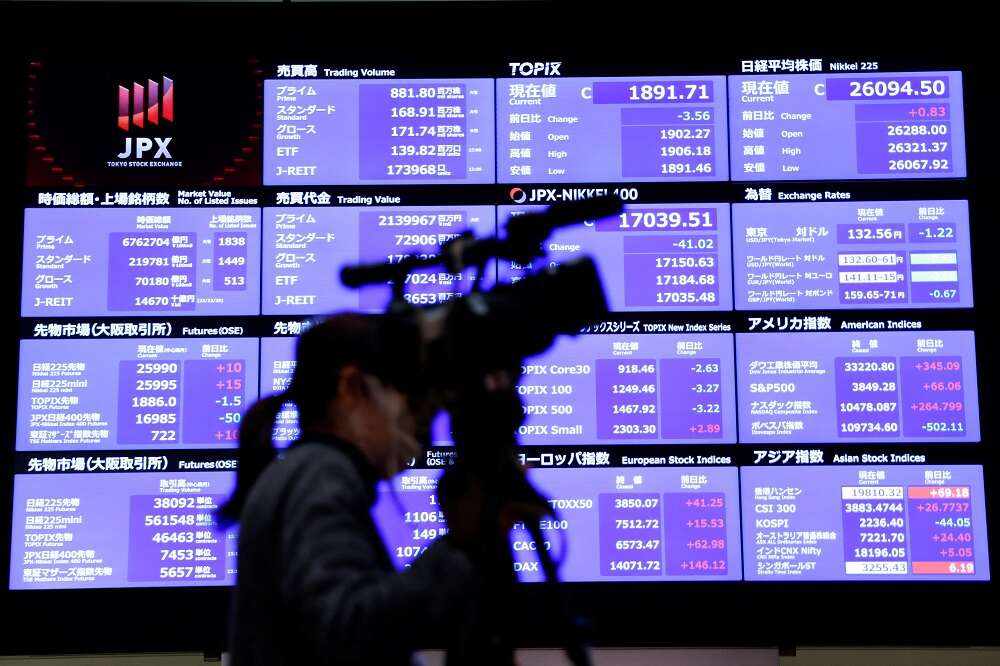
By Herbert Lash and Amanda Cooper
WASHINGTON (Reuters) – Global equity markets slid and the dollar firmed on Monday after data showing a resilient U.S. jobs market suggested interest rates will stay higher for longer as central banks face a tough battle to slow inflation amid relatively strong economic growth.
The blockbuster U.S. jobs report last Friday sent investors scurrying to load up on dollars to the detriment of emerging market assets and lower-yielding currencies like the yen.
Government bonds, which usually perform well when there is a dash for safe havens, have come under intense pressure, sending the benchmark 10-year Treasury yield to a one-month high of 3.64%. The yield on Germany’s 10-year bond, the euro zone benchmark, hit 2.297%.
U.S.-listed shares of China firms fell as Sino-U.S. relations soured over a suspected Chinese spy balloon the U.S. military shot down over the Atlantic. Heavyweights Alibaba Group Holding, JD.com Inc and Pinduoduo Inc fell between 2.4% and 4.7%.
Turkey’s lira hit fresh record lows after a powerful earthquake struck Turkey and Syria, killing more than 2,200 people. The currency sank after data last week showed a worrisome increase in monthly consumer inflation.
The big driver of market sentiment was the U.S. labor market report showing 517,000 jobs were created in January, with the unemployment rate falling to 3.4%, a low last seen in 1969.
This year’s rally in equities has been driven by hopes of a soft landing and lower inflation, said Antho Saglimbene, chief market strategist at Ameriprise Financial in Troy, Michigan.
“Investors are going to have to come to grips with the fact that rates are going to stay higher for longer and it’s still unlikely the Fed is going to cut rates this year,” Saglimbene said, as the strong labor market gives support to inflation .
“Without people fearing that they’re going to lose their job, they don’t really spend less. They don’t change their behaviors enough to start bringing down inflation,” he said.
MSCI’s gauge of stock performance in 47 countries slid 1.09%, while the broad pan-European STOXX 600 index lost 0.95%.
On Wall Street, the Dow Jones Industrial Average fell 0.3%, the S&P 500 lost 0.53% and the Nasdaq Composite dropped 0.65%.
The dollar had touched a three-week high of 132.60 against the lower-yielding yen following reports the Japanese government had offered the job of central bank governor to current deputy Masayoshi Amamiya, viewed as less of a monetary policy hawk than his predecessor.
The dollar rose more than 1.2% to an almost one-month high of 132.85 yen. The euro was down 0.57% to $1.0731.
BALLOONING DRAMA
The drama over the balloon, which Beijing reiterated was a civilian airship that accidentally strayed into U.S. airspace, further strained already-tense relations.
Chinese equities fell on Monday, while the offshore yuan touched a one-month low against the dollar. It has fallen by almost 2% in the space of three days.
“Undoubtedly, the incident is a negative headline for the market,” said Yuan Yuwei, hedge fund manager at Water Wisdom Asset Management.
The dollar’s strength also washed through emerging markets.
The lira bore much of the brunt of the risk-off mood, falling to a record low of 18.85 to the dollar, while the Thai baht posted its biggest one-day fall against the U.S. currency in over 20 years.
The earthquake is source of additional uncertainty ahead of elections in Turkey that most likely will be held in May, said Piotr Matys, senior FX analyst at In Touch Capital Markets.
“More importantly, the U.S. payrolls published last Friday indicated that the Fed is likely to remain in a tightening mode for longer then the markets currently anticipate at a time when President Erdogan strongly indicated he expects the Turkish central bank to cut interest rates,” Matys said.
CENTRAL BANKER DELUGE
A host of Fed officials are set to speak this week, led by Chair Jerome Powell on Tuesday, and the tone could be hawkish. European Central Bank and Bank of England policymakers will also be making appearances.
Futures are almost fully priced for a quarter point U.S. rate rise in March, and likely another in May, leaving the peak now at 5.11% in June from less than 4.9% before the jobs data.
Oil prices edged lower after rising more than $1 as a stronger dollar and fears that slower growth in major economies could curb demand outweighed supply concerns.
U.S. crude fell 1.14% to $72.55 per barrel and Brent was at $79.36, down 0.73% on the day.
(Reporting by Herbert Lash, Additional reporting by Bansari Mayur in Bangalore, Karin Stohecker in London and Wayne Cole in Sydney; Editing by Shri Navaratnam, John Stonestreet, Chizu Nomiyama and Andrea Ricci)


